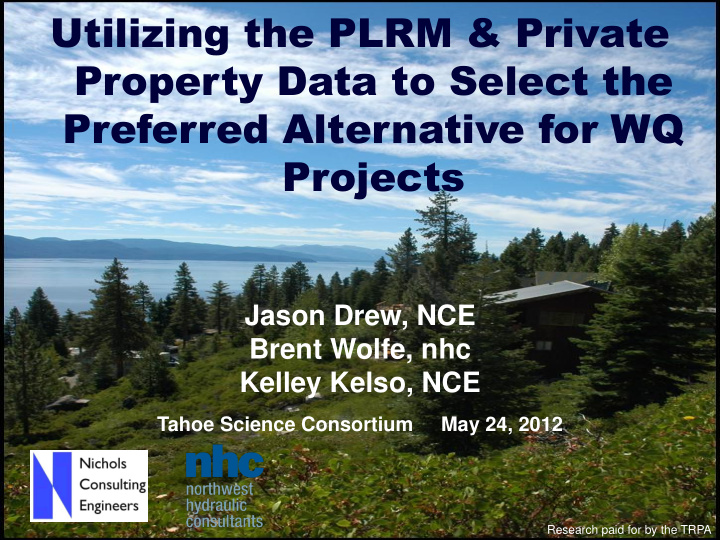



Utilizing the PLRM & Private Property Data to Select the Preferred Alternative for WQ Projects Jason Drew, NCE Brent Wolfe, nhc Kelley Kelso, NCE Tahoe Science Consortium May 24, 2012 Research paid for by the TRPA
Background • Lake Tahoe Basin PDP • FEA including Existing Conditions (ECAM) • Guidance Documents 2004 & 2008 • New Science, Policy & Tools – TMDL, RPU, Basin Plan Amendments – Models including PLRM – Programmatic shift = Emphasize Watershed Approach
Problem • Guidance documents provide limited or no detail on integrating: – TMDL science & tools – Private Property data
Goals & Objectives Goal: • Improve data and info available to implementers and TAC for selecting preferred alternative Objectives: • Provide Guidance on incorporating PLRM into PDP • Present process and tools for incorporating Private Property Data into the PDP and PLRM
PLRM Load Prediction • Model inputs influencing load prediction for private property: – Type land use – Impervious area – Amount of directly connected impervious area (DCIA) – Degree of BMP implementation
Connectivity Theory Potential for high amount of Outlet or Outlet HSC runoff = Potential otential for high or high Facility pollutant pollutant load load Area A Area B DCIA ICIA Area C Area D pervious pervious
Connectivity and BMPs Conceptual example for single family land use
Integrating Private Property BMPs • Watershed Approach = Hydro processes • Private property > Influences hydro processes Photo: www.ogwa-hydrog.ca • Benefits of integrating: – Identify pollutant generation & transport – More accurate PLRM inputs – Outreach priority areas – Identify public/private = Load reduction opps
Case Study – Crystal Bay WQIP • Important Private Property Info – Presence/absence of BMPs – Constrained sites – Connectivity of impervious areas
PLRM Editors
Tools
Process 1. Create a map showing the BMP status of each parcel and calculate the % Area of Land Use 2. Calculate the impervious area without BMPs draining to right of way 3. Calculate the Directly Connected Impervious Area (%DCIA) DCIA Draining to ROW % DCIA to outlet % DCIA of ROW Impervious Area Impervious Area Routed to Infiltrati on Facilities
Crystal Bay Phase II WQIP area For Single Family Residential: Total impervious area = 10.3 acres 2.1 acres valid BMP Cert 10.3 - 2.1 = 8.2 acres no BMP Cert 1.55 acres (orange polygons) directly connected The % DCIA draining to outlet = 1.55 / 8.2 = 19%
Average Annual Fine Sediment Pollutant Loading by % BMP Certificates for 19%, 50%, and 80% DCIA in Crystal Bay Phase II WQIP 800 700 19% DCIA Average Annual FSP Loading (lbs/year) 600 50% DCIA 80% DCIA 500 400 300 Current Estimate Current Estimate for CB II WQIP for CB II WQIP 200 100 0 0% 10% 20% 30% 40% 50% 60% 70% 80% 90% 100% % BMP Certificates
Conclusions • Private Property influences Hydrology • Hydrology influence Load • Density and Connectivity are key factors • Case Study – Crystal Bay = PP not a big factor – Sierra Tract, Lower Kings Beach or Central Incline = Larger influence. Photo by M. Hefner Photo by K. Kelso
Recommend
More recommend